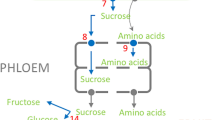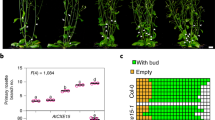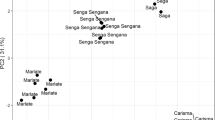Abstract
L-Ascorbic acid (vitamin C) in fruits and vegetables is an essential component of human nutrition. Surprisingly, only limited information is available about the pathway(s) leading to its biosynthesis in plants. Here, we report the isolation and characterization of GalUR, a gene from strawberry that encodes an NADPH-dependent D-galacturonate reductase. We provide evidence that the biosynthesis of L-ascorbic acid in strawberry fruit occurs through D-galacturonic acid, a principal component of cell wall pectins. Expression of GalUR correlated with changing ascorbic acid content in strawberry fruit during ripening and with variations in ascorbic acid content in fruit of different species of the genus Fragaria. Reduced pectin solubilization in cell walls of transgenic strawberry fruit with decreased expression of an endogenous pectate lyase gene resulted in lower ascorbic acid content. Overexpression of GalUR in Arabidopsis thaliana enhanced vitamin C content two- to threefold, demonstrating the feasibility of engineering increased vitamin C levels in plants using this gene.
This is a preview of subscription content, access via your institution
Access options
Subscribe to this journal
Receive 12 print issues and online access
$209.00 per year
only $17.42 per issue
Buy this article
- Purchase on Springer Link
- Instant access to full article PDF
Prices may be subject to local taxes which are calculated during checkout



Similar content being viewed by others
Accession codes
References
Levine, M. New concepts in the biology and biochemistry of ascorbic acid. N. Engl. J. Med. 314, 892–902 (1986).
Davey, M.W. et al. Plant l-ascorbic acid: chemistry, function, metabolism, bioavailability and effects of processing. J. Sci. Food Agric. 80, 825–860 (2000).
Burns, J.J. Ascorbic acid. in Metabolic Pathways, vol. 1 (ed. Greenberg, D.M.) 341–356 (Academic Press, New York, 1960).
Wheeler, G.L., Jones, M.A. & Smirnoff, N. The biosynthetic pathway of vitamin C in higher plants. Nature 393, 365–369 (1998).
Conklin, P.L., Saracco, S.A., Norris, S.R. & Last, R.L. Identification of ascorbic acid-deficient Arabidopsis thaliana mutants. Genetics 154, 847–856 (2000).
Wolucka, B.A. et al. Partial purification and identification of GDP-mannose 3″,5″-epimerase of Arabidopsis thaliana, a key enzyme of the plant vitamin C pathway. Proc. Natl. Acad. Sci. USA 98, 14843–14848 (2001).
Smirnoff, N., Conklin, P.L. & Loewus, F.A. Biosynthesis of ascorbic acid: A renaissance. Annu. Rev. Plant Physiol. Plant Molec. Biol. 52, 437–467 (2001).
Loewus, F.A. & Kelly, S. Identity of L-ascorbic acid formed from D-glucose by the strawberry (Fragaria). Nature 191, 1059–1061 (1961).
Isherwood, F.A., Chen, Y.T. & Mapson, L.W. Synthesis of l-ascorbic acid in plants and animals. Biochem. J. 56, 1–21 (1954).
Loewus, F.A. & Kelly, S. The metabolism of D-galacturonic acid and its methyl ester in the detached ripening strawberry. Arch. Biochem. Biophys. 95, 483–493 (1961).
Mapson, L.W. & Isherwood, F.A. Biological synthesis of ascorbic acid: the conversion of derivatives of D-galacturonic acid into L-ascorbic acid by plant extracts. Biochem. J. 64, 13–22 (1956).
Conklin, P.L. Recent advances in the role and biosynthesis of ascorbic acid in plants. Plant Cell Environ. 24, 383–394 (2001).
Medina-Escobar, N., Cárdenas, J., Valpuesta, V., Muñoz-Blanco, J. & Caballero, J.L. Cloning and characterization of cDNAs from genes differentially expressed during the strawberry fruit ripening process by a MAST-PCR-SBDS method. Anal. Biochem. 248, 288–296 (1997).
Perkins-Veazie, P. Growth and ripening of strawberry fruit. Hort. Rev. 17, 267–297 (1996).
Jez, J.M., Flynn, T.G. & Penning, T.M. A nomenclature system for the aldo-keto reductase superfamily. Adv. Exp. Med. Biol. 414, 579–600 (1997).
Unterlinner, B., Lenz, F. & Kutchan, T.M. Molecular cloning and functional expression of codeinone reductase: the penultimate enzyme in morphine biosynthesis in the opium poppy Papaver somniferum. Plant J. 18, 465–475 (1999).
Mylne, J. & Botella, J.R. Binary vectors for sense and antisense expression of Arabidopsis ESTs. Plant Molec. Biol. Rep. 16, 257–262 (1998).
Jiménez-Bermúdez, S. et al. Manipulation of strawberry fruit softening by antisense expression of a pectate lyase gene. Plant Physiol. 128, 751–759 (2002).
Loewus, F.A., Jang, R. & Seegmiller, C.G. The conversion of C14-labeled sugars to l-ascorbic acid in ripening strawberries. J. Biol. Chem. 222, 649–664 (1956).
Medina-Escobar, N., Cárdenas, J., Moyano, E., Caballero, J.L. & Muñoz-Blanco, J. Cloning, molecular characterization and expression pattern of a strawberry ripening specific cDNA with sequence homology to pectate lyase from higher plants. Plant Molec. Biol. 34, 867–877 (1997).
Conklin, P.L. et al. Genetic evidence for the role of GDP-mannose in plant ascorbic acid (vitamin C) biosynthesis. Proc. Natl. Acad. Sci. USA 96, 4198–4203 (1999).
Gatzek, S., Wheeler, G.L. & Smirnoff, N. Antisense suppression of L-galactose dehydrogenase in Arabidopsis thaliana provides evidence for its role in ascorbate synthesis and reveals light modulated L-galactose synthesis. Plant J. 30, 541–553 (2002).
Davey, M.W. et al. Ascorbate biosynthesis in Arabidopsis cell suspension culture. Plant Physiol. 121, 535–543 (1999).
Jain, A.K. & Nessler, C.L. Metabolic engineering of an alternative pathway for ascorbic acid biosynthesis in plants. Molec. Breed. 6, 73–78 (2000).
Hancock, R.D. & Viola, R. Biotechnological approaches for L-ascorbic acid production. Trends Biotechnol. 20, 299–305 (2002).
Murashige, T. & Skoog, F. A revised medium for rapid growth and bioassays with tobacco culture. Physiol. Plant. 15, 473–497 (1962).
Guan, K.L. & Dixon, J.E. Eukaryotic proteins expressed in Escherichia coli: an improved thrombin cleavage and purification procedure of fusion proteins with glutathione S-transferase. Anal. Biochem. 192, 262–267 (1991).
Harlow, E. & Lane, D. in Antibodies, A Laboratory Manual (Cold Spring Harbor Laboratory Press, Cold Spring Harbor, NY, 1988).
Bechtold, N., Ellis, J. & Pelletier, G. In planta Agrobacterium mediated gene transfer by infiltration of adult Arabidopsis thaliana plants. C.R. Acad. Sci. Paris Life Sci. 316, 1194–1199 (1993).
Rao, M. & Ormrod, D.P. Ozone pressure decreases UVB sensitivity in a UVB-sensitive flavonoid mutant of Arabidopsis. Photochem. Photobiol. 61, 71–78 (1995).
Bradford, M.M. A rapid and sensitive method for the quantification of microgram quantities of protein utilizing the principle of protein-dye binding. Anal. Biochem. 72, 248–254 (1976).
Acknowledgements
The authors thank D. Bradley, J. Jones, F. Loewus, and I. Amaya for critical review of the manuscript, and J. R. Botella for the pSOV2 delivery. This work was supported by grants (BIO98-0496-C02-01) from Ministry of Education and Science (Spain).
Author information
Authors and Affiliations
Corresponding author
Ethics declarations
Competing interests
F.A., M.A.B., and V.V. have filed a patent application relating to the work described in this article.
Rights and permissions
About this article
Cite this article
Agius, F., González-Lamothe, R., Caballero, J. et al. Engineering increased vitamin C levels in plants by overexpression of a D-galacturonic acid reductase. Nat Biotechnol 21, 177–181 (2003). https://doi.org/10.1038/nbt777
Received:
Accepted:
Published:
Issue Date:
DOI: https://doi.org/10.1038/nbt777
This article is cited by
-
Transcriptome comparison analyses in UV-B induced AsA accumulation of Lactuca sativa L
BMC Genomics (2023)
-
Over-expression of FaGalLDH Increases Ascorbic Acid Concentrations and Enhances Salt Stress Tolerance in Arabidopsis thaliana
Journal of Plant Biology (2023)
-
The genome sequencing and comparative analysis of a wild kiwifruit Actinidia eriantha
Molecular Horticulture (2022)
-
Potential of engineering the myo-inositol oxidation pathway to increase stress resilience in plants
Molecular Biology Reports (2022)
-
Vitamin C and fruit quality consensus in breeding elite European strawberry under multiple interactions of environment
Molecular Biology Reports (2022)



